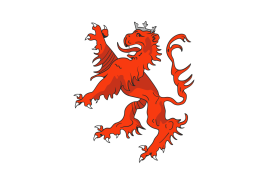Armenian Kingdom of Cilicia
Wednesday, December 11, 2024
The Armenian Kingdom of Cilicia, also known as Cilician Armenia, Lesser Armenia, Little Armenia or New Armenia, and formerly known as the Armenian Principality of Cilicia, was an Armenian state formed during the High Middle Ages by Armenian refugees fleeing the Seljuk invasion of Armenia. Located outside the Armenian Highlands and distinct from the Kingdom of Armenia of antiquity, it was centered in the Cilicia region northwest of the Gulf of Alexandretta.
The kingdom had its origins in the principality founded c. 1080 by the Rubenid dynasty, an alleged offshoot of the larger Bagratuni dynasty, which at various times had held the throne of Armenia. Their capital was originally at Tarsus, and later became Sis. Cilicia was a strong ally of the European Crusaders, and saw itself as a bastion of Christendom in the East. It also served as a focus for Armenian nationalism and culture, since Armenia proper was under foreign occupation at the time. Cilicia's significance in Armenian history and statehood is also attested by the transfer of the seat of the Catholicos of the Armenian Apostolic Church, spiritual leader of the Armenian people, to the region.
In 1198, with the crowning of Leo I, King of Armenia of the Rubenid dynasty, Cilician Armenia became a kingdom.
In 1226, the crown was passed to rival Hethumids through Leo's daughter Isabella's second husband, Hethum I. As the Mongols conquered vast regions of Central Asia and the Middle East, Hethum and succeeding Hethumid rulers sought to create an Armeno-Mongol alliance against common Muslim foes, most notably the Mamluks. In the thirteenth and fourteenth centuries, the Crusader states and the Mongol Ilkhanate disintegrated, leaving the Armenian Kingdom without any regional allies. After relentless attacks by the Mamluks in Egypt in the fourteenth century, the Cilician Armenia of the Lusignan dynasty, mired in an internal religious conflict, finally fell in 1375.
Commercial and military interactions with Europeans brought new Western influences to the Cilician Armenian society. Many aspects of Western European life were adopted by the nobility including chivalry, fashions in clothing, and the use of French titles, names, and language. Moreover, the organization of the Cilician society shifted from its traditional system to become closer to Western feudalism. The European Crusaders themselves borrowed know-how, such as elements of Armenian castle-building and church architecture. Cilician Armenia thrived economically, with the port of Ayas serving as a center for East–West trade.
Demographically, Cilician Armenia was heterogeneous with a population of Armenians who constituted the ruling class, and also Greeks, Jews, Muslims, and various Europeans. The multi-ethnic population, as well as commercial and political links with Europeans, particularly France, brought important new influences on Armenian culture. The Cilician nobility adopted many aspects of Western European life, including chivalry, fashion, and the use of French Christian names. The structure of Cilician society became more synonymous with Western feudalism than to the traditional nakharar system of Armenia. In fact, during the Cilician period, Western titles such as baron and constable replaced their Armenian equivalents nakharar and sparapet. European tradition was adopted for the knighting of Armenian nobles, while jousts and tournaments similar to those in Europe had become popular in Cilician Armenia. The extent of Western influence over Cilician Armenia is also reflected by the incorporation of two new letters (Ֆ ֆ = "f" and Օ օ = "o") and various Latin-based words into the Armenian language.
In other areas, there was more hostility to the new Western trends. Above all, most ordinary Armenians frowned on conversion to Roman Catholicism or Greek Orthodoxy. Cultural influence was not merely one-way, however; Cilician Armenians had an important impact on Crusaders returning to the West, most notably with their architectural traditions. Europeans incorporated elements of Armenian castle-building, learned from Armenian masons in the Crusader states, as well as some elements of church architecture. Most Armenian castles made atypical usage of rocky heights, and featured curved walls and round towers, similar to those of the Hospitaller castles Krak des Chevaliers and Marqab. The Cilician period also produced some important examples of Armenian art, notably the illuminated manuscripts of Toros Roslin, who was at work in Hromkla in the thirteenth century.





